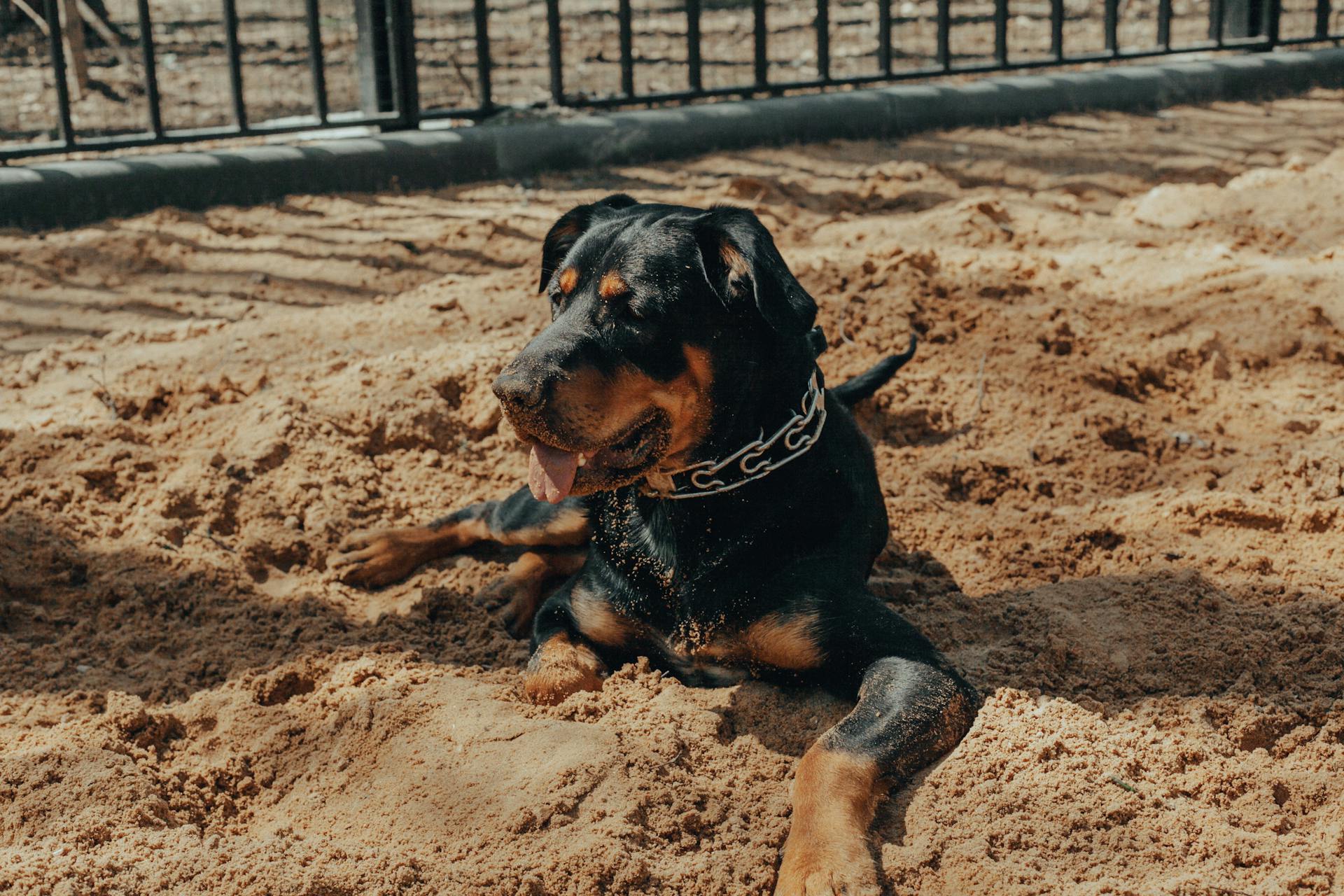
Labradoodles are a popular breed, and for good reason - they're intelligent, friendly, and energetic. They originated in the 1980s as a cross between a Labrador Retriever and a Poodle.
Their unique combination of traits makes them a great choice for many families. Their intelligence and trainability also make them a popular choice for assistance dogs.
Labradoodles are generally medium to large in size, with males weighing between 50-65 pounds and standing 18-22 inches tall. Their coat can vary from straight to curly, and requires regular grooming.
Their high energy levels mean they need plenty of exercise to stay happy and healthy. A daily walk or playtime is a must!
History and Origins
The Labradoodle has a fascinating history that's worth exploring. The breed was first introduced to the Royal Guide Dog Association of Australia in Victoria by Australian breeder Wally Conron.
Conron's goal was to create a guide dog suitable for people with allergies to fur and dander. He wanted to combine the low-shedding coat of a Poodle with the gentleness and trainability of a Labrador Retriever.
The first intentional Labradoodle litter was born in Australia in the 1970s, following a request from a lady in Hawaii for a guide dog that wouldn't cause her allergies to flare up. The Association used a white Standard Poodle from Sweden with excellent working bloodlines to cross with a Labrador.
The first Labradoodle, named Sultan, worked as a guide dog for a woman in Hawaii for ten years. Conron has since expressed regret over initiating the fashion for this type of crossbreed, citing genetic unpredictability and problems being bred into the dogs.
The Labradoodle is one of the best-known and established of the ‘designer crossbreeds’, but it's not recognized by any international kennel clubs.
You might like: When Did Labradoodles Originate
Physical Characteristics
Labradoodles can vary in size, shape, coat types, and temperaments, depending on how they have been bred.
Their colours can vary as well, depending mostly on their parents' coats.
Come in Different Sizes
Labradoodles come in three different sizes: standard, medium, and miniature. Their weight and size range from 10-40kg and 30-71cm.

The size of a Labradoodle largely depends on the size of its Poodle parent. This makes sense, as Poodles come in a range of sizes, from toy to standard.
Miniature Labradoodles typically weigh around 18-28 pounds. Medium Labradoodles, on the other hand, can weigh anywhere from 26-45 pounds.
Standard Labradoodles are the largest of the bunch, weighing in at 45-75 pounds.
Curious to learn more? Check out: Standard Poodle vs Labradoodle
Appearance
Labradoodles come in a variety of colours, including chocolate, cream, black, silver, red, apricot, and a mix.
Their coat types can vary, ranging from wavy to wiry, curly, or even straight hair.
Labradoodles' coat colors can be chocolate, cafe, parchment, cream, gold, apricot, red, black, silver, chalk, lavender, and blue-ish gray.
Coat patterns can be solid, white abstract markings, parti, phantom, or tri-coloured.
Labradoodles' hair can be anywhere from wiry to soft, and may be straight, wavy, or curly.
Their coat texture and color can vary depending on their parents' coats.
Labradoodles can display an affinity for water and strong swimming ability from their parent breeds.
Their coat types can vary, but wool, fleece, or hair are the three main categories.
See what others are reading: Black White Lab Mix
Don't Shed
Labradoodles don't shed, a trait that's especially appealing to people with allergies.
Most Labradoodles have Poodle type hair - a tightly curled coat that doesn't shed.
Intriguing read: Do Labradoodles Shed More than Goldendoodles
Health
Labradoodles can be prone to hip dysplasia, a common problem shared with their parent breeds.
Their parent breeds can also have a number of eye disorders.
Labradoodles can also experience neurological disorders, including epilepsy.
Regular veterinary check-ups are crucial to catch any potential health issues early on.
Labradoodles are generally a healthy breed, but they can be sensitive to certain health problems due to their parent breeds.
It's essential to keep an eye out for any signs of illness or discomfort in your Labradoodle.
With proper care and attention, many Labradoodles can live long and happy lives.
Explore further: Common Problems with Labradoodles
Personality and Temperament
Labradoodles are a joy to be around, and their friendly nature makes them a great addition to any family. They are easy-going and keen to be friends with everyone, making them suitable for households with other pets and young children.
Labradoodles are highly intelligent and love to please, which means they respond well to consistency and positive reinforcement. They're extremely motivated by food, so using treats to reward good behavior is a great way to train them.
One thing to keep in mind is that Labradoodles can be destructive if they become bored, so they need plenty of mental stimulation. This can be achieved through puzzle feeders, games, and activities that challenge their minds.
Labradoodles are also prone to separation anxiety, so they may not be the best fit for households where owners are away for long periods of time. However, with proper training and socialization, they can learn to tolerate being alone for short periods.
Here are some key personality traits to keep in mind when considering a Labradoodle:
- Easy-going and keen to be friends with everyone
- Suitable for households with other pets and young children
- Highly intelligent and love to please
- Prone to separation anxiety
- Need plenty of mental stimulation to prevent boredom
Grooming and Nutrition
Labradoodles require regular grooming to maintain their coat, which can vary depending on their parent's genes. They come in three coat varieties: hair coat, wool coat, and fleece coat, all of which are considered non to low shedding.
To keep their coat looking its best, it's essential to brush your Labradoodle twice a week, with a trip to the groomer's two to four times per year. Bathing should be done only when they are visibly dirty or smelly, as frequent bathing can dry out their skin and cause itchiness.
Here are some grooming tips to keep in mind:
- Check for lumps, bumps, and parasites while grooming.
- Brush your Labradoodle's teeth as often as possible to prevent gum disease and associated issues.
In terms of nutrition, Labradoodles require a high-quality diet that meets all of their nutritional requirements. They may not be fussy eaters, but it's essential to feed them a balanced diet to prevent health conditions such as heart disease and hip dysplasia.
Grooming Guide
Labradoodles have varying coats, ranging from tight curls to loose, flowing locks of hair. Regular brushing and visits to a professional groomer are essential, even though they have low-shedding levels.
The breed comes in three coat varieties: hair coat, wool coat, and fleece coat. Each type requires different grooming needs.
Brush your Labradoodle's coat twice a week to prevent matting and tangling. You should also aim to visit a professional groomer two to four times a year.
Bathing your Labradoodle too frequently can dry out their skin and cause itchiness. Only bathe them when they're visibly dirty or smelly.
Labradoodles are prone to ear infections due to excessive hair inside their ears. Regular ear care is crucial to prevent this.
Here are some grooming tips to keep in mind:
- Check for lumps, bumps, and parasites while grooming.
- Brush your Labradoodle's teeth as often as possible to prevent gum disease.
Nutrition
Nutrition is a crucial aspect of your Labradoodle's overall health and well-being. A balanced diet will help your pup maintain a healthy weight and avoid health conditions such as heart disease and hip dysplasia.
To ensure your Labradoodle gets the nutrients they need, choose a high-quality dog food that meets all their nutritional requirements. You can opt for a World Small Animal Veterinary Association-compliant food, such as Purina ProPlan, Hill's Science Diet, or Royal Canin.
A unique perspective: Labradoodle
Labradoodle puppies should be fed a restricted diet to slow their growth, as growing too quickly can lead to joint problems. Your vet will be able to advise on the best diet for your dog.
Adult Labradoodles should be fed twice a day to spread their daily calorie intake across meals. This can help prevent serious health issues, such as gastric dilatation-volvulus (GDV).
Remember to keep a close eye on your Labradoodle's weight by using portion control and limiting snacks. This will help prevent overeating and maintain a healthy weight.
Here are some general feeding guidelines for Labradoodles:
It's also essential to provide your Labradoodle with access to fresh water at all times. A constant supply of fresh water will help keep your dog in ideal shape, and regular body condition scores can help ensure you're meeting their nutritional needs.
Pet Care and Ownership
Labradoodles have a unique coat that requires regular grooming to prevent matting and tangling. They can weigh between 50-75 pounds and stand about 25 inches tall when fully grown.
Labradoodles are known for their friendly and loyal nature, making them a great fit for families with children. They are also relatively easy to train, especially for first-time pet parents.
To keep your Labradoodle happy and healthy, it's essential to provide at least one hour of exercise daily, which can include walks, playtime in the yard, or a trip to the dog park.
Pet Care Considerations
Labradoodles require a lot of exercise, ideally at least one hour a day, to keep them happy and healthy.
They need regular grooming sessions to prevent matting and knotting of their long, curly coats, which can be a challenge.
Labradoodles can thrive in homes of all sizes as long as they get enough physical and mental stimulation, although a yard is preferred.
Their high energy levels mean they need to be taken on long, interesting walks, and they can remain playful well into their senior years.
For another approach, see: How Long Do Australian Labradoodles Live
You'll need to be prepared to give them lots of attention and training from an early age to minimize mischievous tendencies and make grooming sessions easier.
Their friendly and loyal nature makes them wonderful family dogs, but they do require a lot of time and effort to care for properly.
Labradoodles are easy to train, making them ideal for first-time pet owners, but they can be quite stubborn at times.
Their big personalities mean they need owners who are easy-going and willing to supply the time, energy, and training to meet their needs.
No dog is truly hypoallergenic, but Labradoodles are known for their minimal shedding, making them a good choice for people with allergies.
You might enjoy: Are Labradoodles Easy to Train
What to Know Before Buying or Rehoming a Dog
Labradoodles are easy-going, adaptable dogs that will suit most lifestyles, but they're big, energetic dogs who need mental and physical stimulation to stop them getting bored.
If you're considering rehoming a Labradoodle, it's essential to choose a licensed and reputable breeder who will provide proof of genetic testing, like hip and elbow scores, for both parents to help you choose a healthy dog.
Labradoodles can master new tricks quickly, making them fun to train, but they're naturally confident, so it's crucial to let them know who's in charge early on.
Be fussy about the breeder you choose, as 'Lucy's Law' dictates that new puppies or kittens must be bought directly from a breeder or adopted from rescue - third party sellers are illegal.
Here are some key things to consider when choosing a breeder:
As crossbreeds, Labradoodle characteristics aren't as ingrained as their parents, so it's essential to see both mum and dad to obtain an accurate idea of personality, size, and colour.
Frequently Asked Questions
What are some fun facts about Labradoodles?
Labradoodles originated in the 1980s and are known for their unique characteristics, including hypoallergenic coats, trainability, and love for water and work. Discover more about this intelligent and versatile breed that's perfect for active families and service dog roles.
What is the downside to a Labradoodle?
Labradoodles require regular exercise to thrive, making them unsuitable for busy owners. Without enough physical activity, they may develop behavioral issues or depression.
Do Labradoodles like to cuddle?
Labradoodles are very loving and adore to cuddle when they feel tired or need attention. They make great companions for those who enjoy snuggling with their pets.
What is unique about Labradoodles?
Labradoodles have a unique, low-shedding coat inspired by poodles, making them a great option for those with allergies. This distinctive trait sets them apart from many other breeds.
Do Labradoodles bark a lot?
Labradoodles are considered medium barkers, typically barking only when they need attention, food, or are frustrated. They're generally quiet, but may vocalize more than other breeds in certain situations.
Sources
- https://wamiz.co.uk/dog/advice/30274/labradoodle-12-fun-facts-about-this-crossbreed-you-should-know
- https://en.wikipedia.org/wiki/Labradoodle
- https://www.petmd.com/dog/breeds/labradoodle
- https://www.petplan.co.uk/pet-information/dog/breed/labradoodle/
- https://www.purina.co.uk/find-a-pet/dog-breeds/labradoodle
Featured Images: pexels.com


